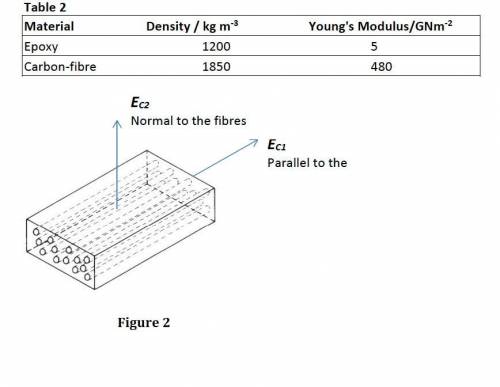
Engineering, 16.12.2020 02:30 dianamachado14
**figure screen shot attached**
A composite component (such as shown in Fig.2) is required for an aerospace application. The specification for the component stipulates that it must have an Elastic Modulus in the fibre direction of at least 320 GN/m2, and the transverse direction modulus must not be less than 8 GN/m2, but with a maximum permissible density of 1650 kg/m3. In order to determine if such a composite is possible:
i) Plot (preferably using excel), the composite modulus (Ec) versus fibre volume fraction (Vf) showing upper (isostrain model – parallel to the fibres) and lower (isostress model - perpendicular to the fibres) bounds for the Epoxy/Carbon-fibre composite (data are provided in Table 2);
ii) Estimate the carbon fibre volume fraction required to achieve the above specification.
(Hint from the plot in part i) find the Vf for the required modulus [320 GPa] in the fibre direction – upper bound line, then check if the lower limit is okay, finally workout the density of the composite to see if it is within the spec – also check your answer with calculations)


Answers: 2
Another question on Engineering

Engineering, 03.07.2019 14:10
Line joining liquid phase with liquid and solid phase mixture is known as: a) liquidus b) solidus c) tie line d) none of the mentioned
Answers: 2

Engineering, 03.07.2019 15:10
Two flowing streams of argon gas are adiabatically mixed to form a single flow/stream. one stream is 1.5 kg/s at 400 kpa and 200 c while the second stream is 2kg/s at 500 kpa and 100 ? . it is stated that the exit state of the mixed single flow of argon gas is 150 c and 300 kpa. assuming there is no work output or input during the mixing process, does this process violate either the first or the second law or both? explain and state all your assumptions.
Answers: 1

Engineering, 04.07.2019 18:10
The thermal expansion or contraction of a given metal is a function of the f a)-density b)-initial temperature c)- temperature difference d)- linear coefficient of thermal expansion e)- final temperature f)- original length
Answers: 2

Engineering, 04.07.2019 18:20
An engine runs on the ideal diesel cycle. the cycle has a compression ratio of 20 and a cutoff ratio of 2. the highest temperature in the cycle is 1200 k. if the heat into the system is 300 kj/kg of working fluid and using variable specific heats determine the work produced per mass of working fluid
Answers: 3
You know the right answer?
**figure screen shot attached**
A composite component (such as shown in Fig.2) is required for an a...
Questions


Mathematics, 30.11.2020 07:20

Social Studies, 30.11.2020 07:20

Mathematics, 30.11.2020 07:20

Mathematics, 30.11.2020 07:20

Mathematics, 30.11.2020 07:20


Mathematics, 30.11.2020 07:20

Mathematics, 30.11.2020 07:20

History, 30.11.2020 07:20

English, 30.11.2020 07:20

Mathematics, 30.11.2020 07:20

Mathematics, 30.11.2020 07:20


English, 30.11.2020 07:20

Advanced Placement (AP), 30.11.2020 07:20


Chemistry, 30.11.2020 07:20


Biology, 30.11.2020 07:20



